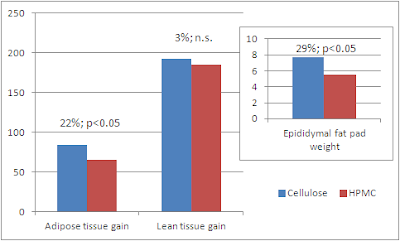When fiber ain't fiber, natural is not naturally better
Being aware of the partly contradictory results previous studies on the metabolic effect (as measured in the lab and not by the way your poo-poo looks or how often you have to go to the toilette, like the "experts" like to do it ;-), Ajmila Islam and her colleagues fed a group of 6 week-old male Wistar rats a standardized rodent chow (AIN-93G, composition see figure 1 in previous blogpost) with either hydroxypropyl-
methylcellulose (HPMC) or standard cellulose as a source of dietary fiber, which comprised 5% of the animals' otherwise totally identical diets. This obviously sounds nonsensical if you follow the usual black or white approach to nutrition (which btw. is propagated by the mainstream and the ANTIs, as well), after all fiber is fiber and should be good or bad!? Well, it turns out that there are more than subtle differences in
- the viscosity of the fiber / fiber food mixture, and
- the fermentability of different types of dietary fiber
Hydroxypropyl-methylcellulose, short HPMC, is a semisynthetic, inert, viscoelastic polymer that is used as an ophthalmic lubricant, as well as an excipient and controlled-delivery component in oral medicaments, and has, under the disguise of the "E-number" E464, already found its way into a lot of commercially produced foodstuff, where it is used as an emulsifier, thickening and suspending agent, and as an alternative to animal gelatin.
While its artificial origin will obviously make the ANTI faction cry out loud, again, I suggest you first read about the effect HPMC had on the animals, before you totally discard it as being "not natural", "non paleo", "the work of Monsatan" or whatever...(btw. it is at least kosher ;-) |
| Figure 1: Changes in body composition (weights in g) after 6 weeks on standard diet with either non-viscous cellulose or viscous hydroxypropyl-methylcellulose as the primary source (5%) of dietary fiber (data adapted from Islam. 2011). |
 |
| Figure 2: Changes (relative to cellulose group) in gene expression in liver and soleus muscle of HMPC fed rats (data adapted from Islam. 2011). |
 |
| Figure 3: Changes (relative to cellulose group) in glucose metablism and adipokine expression of HMPC fed rats (data adapted from Islam. 2011). |
"Fiber is good, then! Right?"
Contrary to cellulose and fermentable viscous fiber, such as guar gum, of which a 2010 study by Isken et al. (Isken. 2010) found that it had, fed at 10% of the diet of mice, no effect on body fat levels in the short term (15 weeks) and even increased adiposity in the long-term (from 27 weeks to 43 weeks), short term feeding with 5% hydroxypropyl-methylcellulose (HPMC) exhibited unexpectedly profound beneficial effects on the metabolism of these otherwise healthy and normally fed (this is important, because we usually see fiber supplementation in the context of "high fat" diets) rodents.
Whether it would be advisable to deliberately look for the number E464 on the foods you consume is yet still highly questionable. For one, every food with an "E -number" on its ingredient list should disappear from your grocery list, anyways. I do not care which number it is, but if food has "E"'s in it chances that this is highly processed garbage are 99% and in that case the supposedly insignificant amount of HPMC will not turn junk into health food. And secondly, and certainly more importantly, we are just beginning to understand how the viscosity of the foods we eat and their susceptibility to fermentation interact and which impact(s) these characteristics have on our digestion and metabolism. After all, it could well be possible that, just as in the Isken study, this beneficial short term effects eventually fire back and the formerly lean HMPC rats suddenly start gaining weight (and body fat) like crazy... you see, as usual things are more complicated than the innocent (yet actually invalid) question "Is fiber good or bad?" might suggest.











0 comments:
Post a Comment